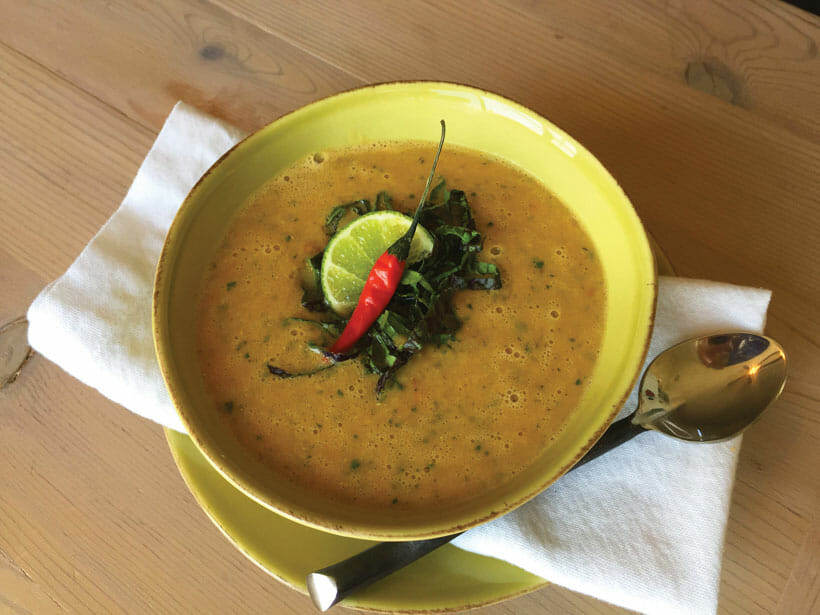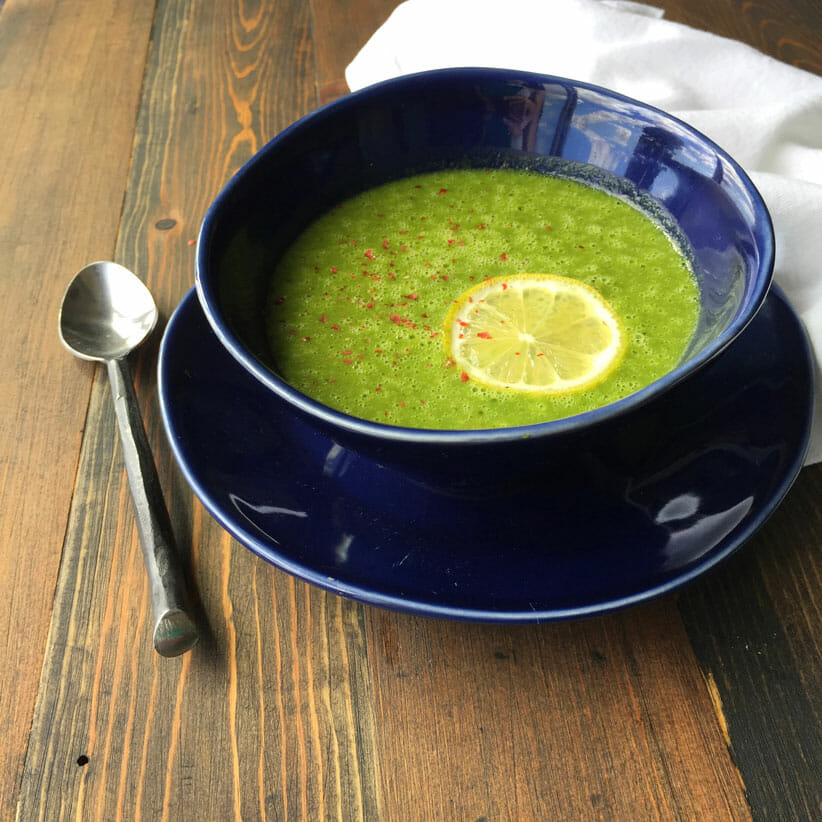
Spring into the Season with Spring Recipes
In our fast-paced, 24/7 culture, it is easy to shield ourselves from the natural rhythms of the day, month, or year. Everyday things like electricity, air conditioners, and even cars, keep us insulated from the external environment and distance us from nature. But the wisdom tradition of Ayurveda has long understood what modern science is now verifying. Our bodies flow in a circadian rhythm, influenced by the sun, moon and seasons. When we live in sync with these rhythms, we can experience optimal health. One of the ways we can do this is by integrating spring recipes, foods, and herbs.
The Season of Renewal
In nature, spring is a time of renewal and growth. Flowers emerge from the melting snow as the dormant, dark, winter weather is replaced by the cool, damp days of spring. The days become longer and brighter. Snow melts and streams swell with run-off. Our bodies assimilate this excess dampness which can lead to increased congestion in the sinuses, lungs, and lymphatic system. Spring colds, coughs, and allergies may leave us feeling sluggish and foggy. Everyone experiences these seasonal influences to some degree, regardless of their constitution or doshic balance or combination. Our bodies are working to shake off the lethargy of winter and prepare for renewal. To assist our bodies’ natural intelligence, we can transition to a diet that will facilitate gentle cleansing and rejuvenation.
Seasonal Spring Recipes
Ayurveda believes that opposite qualities will bring balance, and like qualities will create imbalance. Spring is similar to the energy of kapha (cool, damp, slow and heavy). Eating foods that have the opposite qualities (hot, dry, airy and light) will balance the seasonal influence. So during cool, damp weather when you are feeling congested and sluggish, add some foods to your diet with these qualities:
1. Pungent/spicy (garlic, green chilies, ginger, lemongrass, radish, watercress, onion, wasabi).
2. Drying (millet, mushrooms, polenta, barley, white potatoes, winter squash).
3. Light (sprouts, popcorn, beans, lentils).
In general, in this season, you want to minimize foods that are cold, heavy and damp (or that cause fluid retention) such as cheese, yogurt, milk, cream, sour foods (lemons, vinegar), salt, Vegemite™, oily fried foods, wheat, refined sugar, and red meat.
Understand that these lists are neither comprehensive nor rigid. Be creative, flexible and compassionate with your implementation of these guidelines. Ayurveda is about finding balance—if you are unhappy, that is not balanced.
Ayurveda and the Doshas
Ayurveda is an ancient system of medicine from India. It is founded on the principle that everyone has a unique energetic constitution made up of a combination of the doshas. There are three main dosha categories: vata, pitta and kapha. Elements are used as metaphors to describe the qualities of the doshas. In general, vata is associated with the element “air” which has the quality of dry, light, cold, and mobile. Pitta is mostly associated with the element of fire which has the qualities of hot, sharp, penetrating, and spreading. And kapha is associated with the elements water and earth, which have the qualities of being cool, damp, soft, slow, and heavy. Everyone is comprised of all the elements and all the doshas, but typically one or two elements and doshas will dominate.
The metaphoric energy that is used to describe our dosha can also be used to describe our environment, our food and our emotions (for example, chilies, the season of summer, and an angry boss are all related to the element of fire and pitta dosha). Ayurveda teaches us to recognize these energies and their influences on us so we can learn to make conscious choices to keep our bodies healthy, our minds calm, and our hearts full of love.

Red Lentil Lemongrass Soup
Makes 2 servings
Vegan, Gluten-free, Soy-free
The recipe is great for spring. The combination of lemongrass and pippali work together to support the body’s natural capacity to cleanse and rejuvenate. Pippali (also known as Piper longum or Indian long pepper) is a rejuvenating force that supports the respiratory system while soothing the nervous system. It is especially balancing for the energy of both kapha and vata. It is used in Ayurveda to support immunity and fortify the lungs. Lemongrass promotes cleansing of the lymphatic system and is soothing to the body and mind.
Ingredients
2 tablespoons sunflower oil
4 tablespoons ginger lemongrass paste
¼ teaspoon Himalayan salt
1 teaspoon organic pippali powder
2 plum tomatoes, peeled, chopped
2/3 cups organic red lentils or masoor dal
4 cups water
2 tablespoons lime juice (or to taste)
4 tablespoons cilantro (or to taste)
Julienned steamed Swiss chard or mustard leaves (optional garnish)
Instructions
In a medium pan, warm the sunflower oil over medium-low heat.
Add the lemongrass paste, salt, and pippali powder.
Sauté until fragrant (about 30 seconds).
Stir in the tomato.
Add the lentils and water.
Bring to a boil, then reduce heat and simmer, uncovered for 10 minutes or until lentils are soft.
The lentils will lose their shape and become somewhat mushy.
Add the lime juice and cilantro.
For a creamy consistency, you can purée with an immersion blender.
Adjust lime juice/cilantro to taste.
Serve immediately.
Serving Suggestions
To reduce excess kapha, garnish with julienned steamed mustard leaves (which will add more kick to this dish). To balance pitta and vata constitutions, garnish with steamed Swiss chard.
Tips
Purchase lemongrass stalks and lime leaves at your local Asian market, then freeze extras in air-tight bags for later use. Pippali powder can be purchased at Indian markets or online sites that sell Ayurvedic herbs. Pippali can be used in place of crushed black pepper in most recipes or any time you want to lend some support to the respiratory system.

Ginger Lemongrass Paste
Makes 1/3 cup
Vegan, Gluten-free, Soy-free
This ginger lemongrass paste is ideal for balancing kapha during the spring or any time the weather is cold and damp. The ginger, chili, and lemongrass help to stoke the digestive fire, clear sinus congestion, and move lymphatic stagnation.
Add this paste to soups, vegetables, and coconut curries, or dilute with water to use as a sauce for fish, jackfruit, or tempeh.
Ingredients
1 tablespoon sunflower oil
¼ brown onion
1 lemongrass stalk, ends trimmed, tough outer layers removed
½ inch ginger root, peeled
¼ inch turmeric root, peeled (or 1/8 teaspoon turmeric powder)
½ Thai red chili, stem removed
1 small kaffir lime leaf, vein removed (or 1 teaspoon lime zest and ½ teaspoon lemon zest)
1 clove garlic
Instructions
In a blender add the sunflower oil, onion, lemongrass, ginger, turmeric, chili, lime leaves and garlic. Blend to a thick paste. (Alternatively, you can do this with a mortar and pestle if you have the patience.)
Transfer to an airtight glass container and store in the refrigerator for up to two days.
Tips
Purchase lemongrass stalks and lime leaves at your local Asian market, then freeze extras in airtight bags for later use.
Make ahead
This lemongrass paste can be prepped up to two days in advance and stored in the refrigerator in an airtight container, which will make life a little easier if you are rushing to get dinner on the table.

Lemon-Potato Chard Soup
Makes 2 servings
Vegan, Gluten-free, Soy-free
Light and smooth, this purée of Swiss chard and potato is an easy tri-doshic lunch or dinner for spring. Swiss chard is less bitter and more soft than most leafy greens, making it a good choice for cooking that aims to balance all three doshas.
Ingredients
1 tablespoon sunflower oil
½ onion, chopped
½ inch ginger root, peeled, chopped
¾ teaspoon cumin seeds
¼ teaspoon turmeric
½ teaspoon crushed black pepper
Pinch ajwain
½ teaspoon Himalayan salt
½ russet potato, peeled, chopped
4 cups vegetable broth
1 bunch Swiss chard leaves, stems and middle vein removed and discarded
1 tablespoon lemon juice
pink peppercorn (optional garnish)
lemon slices (optional garnish)
Instructions
In a medium pan, warm the oil over low heat.
Add the onion, ginger, and cumin seeds.
Sauté for 2 minutes.
Add turmeric, pepper, ajwain, and salt; sauté for 1 minute.
Add the potato and broth.
Bring to a boil, then reduce heat to low and simmer for 20 minutes, or until the potato is soft. Add the Swiss chard.
Cover and remove from heat; allow the chard to wilt.
Transfer to blender and purée.
Ladle into serving bowls and garnish with pink peppercorn and lemon slices if desired.
Lois Leonhardi is a certified Ayurveda wellness practitioner, educator and author of “The Essential Ayurvedic Cookbook”. She trained under Dr. Lad at the Ayurvedic Institute in New Mexico and in Pune, India. She has over 20 years of training in holistic studies (Ayurveda, yoga and meditation). Lighthearted and compassionate, she listens to your concerns and creates realistic personalized programs to help you de-stress, detox and restore balance naturally. Sharing the wisdom of the mind-body connection and how to use food as medicine, she reveals the secrets of how to slow the aging process, increase energy and bolster immunity giving you the tools to heal yourself, feel better and look great. www.yogawithlois.com
